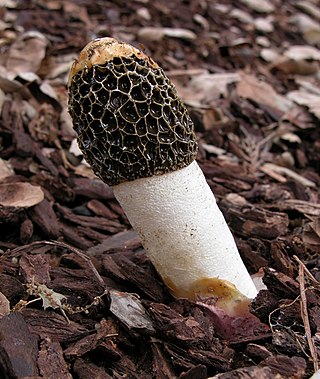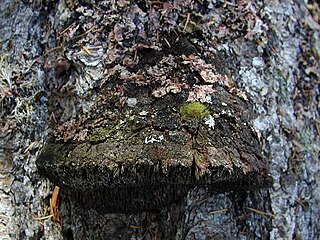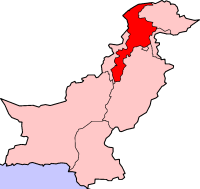
Phallus indusiatus, commonly called the bamboo mushrooms, bamboo pith, long net stinkhorn, crinoline stinkhorn, bridal veil, or veiled lady, is a fungus in the family Phallaceae, or stinkhorns. It has a cosmopolitan distribution in tropical areas, and is found in southern Asia, Africa, the Americas, and Australia, where it grows in woodlands and gardens in rich soil and well-rotted woody material. The fruit body of the fungus is characterised by a conical to bell-shaped cap on a stalk and a delicate lacy "skirt", or indusium, that hangs from beneath the cap and reaches nearly to the ground. First described scientifically in 1798 by French botanist Étienne Pierre Ventenat, the species has often been referred to a separate genus Dictyophora along with other Phallus species featuring an indusium. P. indusiatus can be distinguished from other similar species by differences in distribution, size, color, and indusium length.

The genus Phallus, commonly known as stinkhorns, is a group of basidiomycetes which produce a phallic, often foul-scented mushroom, from which their name is derived. The genus has a widespread distribution and, according to a 2008 estimate, contains 18 species. They belong to the family Phallaceae in the order Phallales. The best known species is the common stinkhorn.

Puccinia recondita is a fungus species and plant pathogen belonging to the order of Pucciniales and family Pucciniaceae.
Shiraia bambusicola is a parasitic fungus on twigs of several genera of bamboos, and its relatively large stromata are used in traditional Chinese medicine. It is the sole species in the monotypic genus Shiraia. It is widely distributed in many provinces of Southern China and also in Japan.

Phallus hadriani, commonly known as the dune stinkhorn or the sand stinkhorn, is a species of fungus in the Phallaceae (stinkhorn) family. It is a widely distributed species, and is native to Asia, Europe, and North America. In Australia, it is probably an introduced species. The stalk of the fruit body reaches up to 20 cm (7.9 in) tall by 4 cm (1.6 in) thick, and is spongy, fragile, and hollow. At the top of the stem is a ridged and pitted, thimble-like cap over which is spread olive-colored spore slime (gleba). Shortly after emerging, the gleba liquefies and releases a fetid odor that attracts insects, which help disperse the spores. Said to be edible in its immature egg-like stage, it typically grows in public lawns, yards and gardens, usually in sandy soils. Phallus hadriani may be distinguished from the similar P. impudicus by the presence of a pink or violet-colored volva at the base of the stem, and by differences in odor.

Echinodontium is a genus of fungi in the family Echinodontiaceae. The genus was published by American mycologist Job Bicknell Ellis in 1900, who described it thus: "Differs from Hydnum in the thick, woody pileus of Fomes and the teeth beset with spines, as in Mucronophorus and Hymenochaete". The type species, Echinodontium tinctorium, is commonly known as the "indian paint fungus" owing to its traditional use for bodypainting.

Itajahya is a fungal genus in the family Phallaceae. The genus, widespread in tropical and subtropical areas, contains three species. Characters in this genus include a white calyptra, and lamellate plates covered with gleba. The gleba has a white mottled surface, and the cap appears wig-like when removed of the gleba. The thick, stout stalk has many chambered walls. The species Itajahya rosea, formerly classified in the genus Phallus, was transferred to Itajahya in 2012 when molecular phylogenetic analysis revealed that it was not closely related to other Phallus species.
Engleromyces is a genus of fungi in the family Xylariaceae. The genus contains two species, the type Engleromyces goetzei and E. sinensis, described as new in 2010. The genus was circumscribed in Bot. Jahrb. Syst. Vol.28 on page 327 in 1900 by German mycologist Paul Christoph Hennings.

Hygrophoropsis is a genus of gilled fungi in the family Hygrophoropsidaceae. It was circumscribed in 1888 to contain the type species, H. aurantiaca, a widespread fungus that, based on its appearance, has been affiliated with Cantharellus, Clitocybe, and Paxillus. Modern molecular phylogenetic analysis shows that the genus belongs to the suborder Coniophorineae of the order Boletales.

Cerocorticium is a genus of seven species of crust fungi in the family Meruliaceae.

Lopharia is a genus of fungi in the family Polyporaceae. The genus was circumscribed by Károly Kalchbrenner and Peter MacOwan in 1881.

The gasteroid fungi are a group of fungi in the Basidiomycota. Species were formerly placed in the obsolete class Gasteromycetes Fr., or the equally obsolete order Gasteromycetales Rea, because they produce spores inside their basidiocarps rather than on an outer surface. However, the class is polyphyletic, as such species—which include puffballs, earthstars, stinkhorns, and false truffles—are not closely related to each other. Because they are often studied as a group, it has been convenient to retain the informal (non-taxonomic) name of "gasteroid fungi".

Phallus calongei is a species of stinkhorn mushroom. Found in Pakistan, it was described as new to science in 2009. Starting out as an "egg", the fully expanded fruit body consists of a single, thick, stipe with a cap attached to the apex and covered with olive-green, slimy spore-containing gleba. It is distinguished from other similar Phallus species by a combination of features, including a pinkish, reticulated (network-like) cap, and a stipe that is tapered at both ends. The edibility of the mushroom is unknown.
Bambusiomyces is a fungal genus in the family Ustilaginaceae. It was circumscribed in 2011 to contain the smut fungus formerly known as Ustilago shiraina, originally described by German mycologist Paul Christoph Hennings from Japan in 1900. The fungus was originally found growing on wild Japanese bamboo, Bambusa veitchii, but has since been isolated from several plants belonging to tribe Bambuseae in the grass family Poaceae. In addition to Japan, it is also found in China and other locales in southeast Asia, and has been introduced to the United States.

Marasmius amazonicus is a species of agaric fungus in the family Marasmiaceae. Described as new to science in 1904 by mycologist Paul Christoph Hennings, it is found in South America.

Sarcodon thwaitesii is a species of tooth fungus in the family Bankeraceae. It is found in Asia, Europe, and New Zealand, where it fruits on the ground in mixed forest.
Bondarzewia guaitecasensis is a species of polypore fungus in the family Russulaceae that is found in South America. Originally described as Polyporus guaitecasensis by German mycologist Paul Christoph Hennings in 1900, it was transferred to the genus Bondarzewia by Jorge Eduardo Wright in 1964. The fungus is parasitic on species of Nothofagus.
Cerocorticium molle is a species of crust fungus in the family Meruliaceae.












